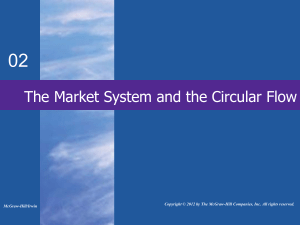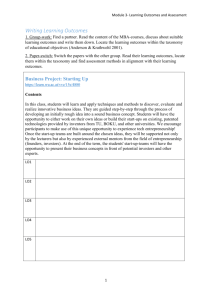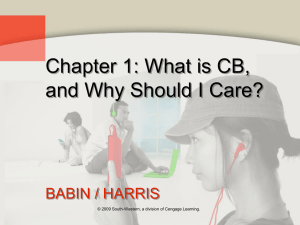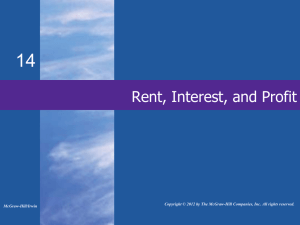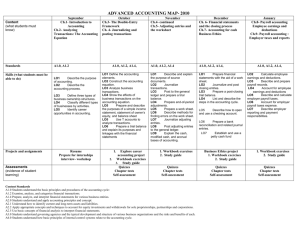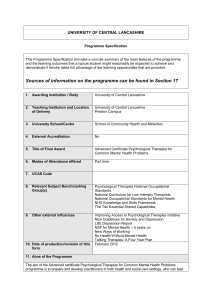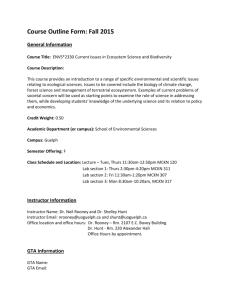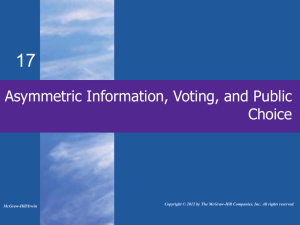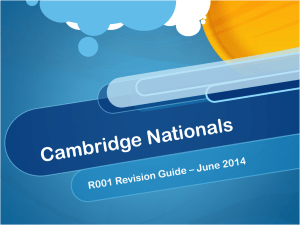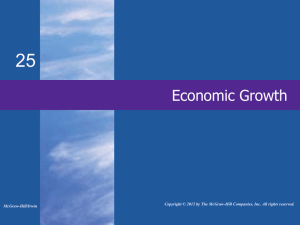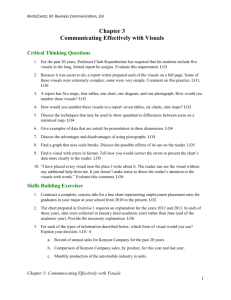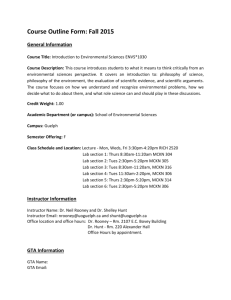MGTK 350 341 Organizational Behavior
advertisement
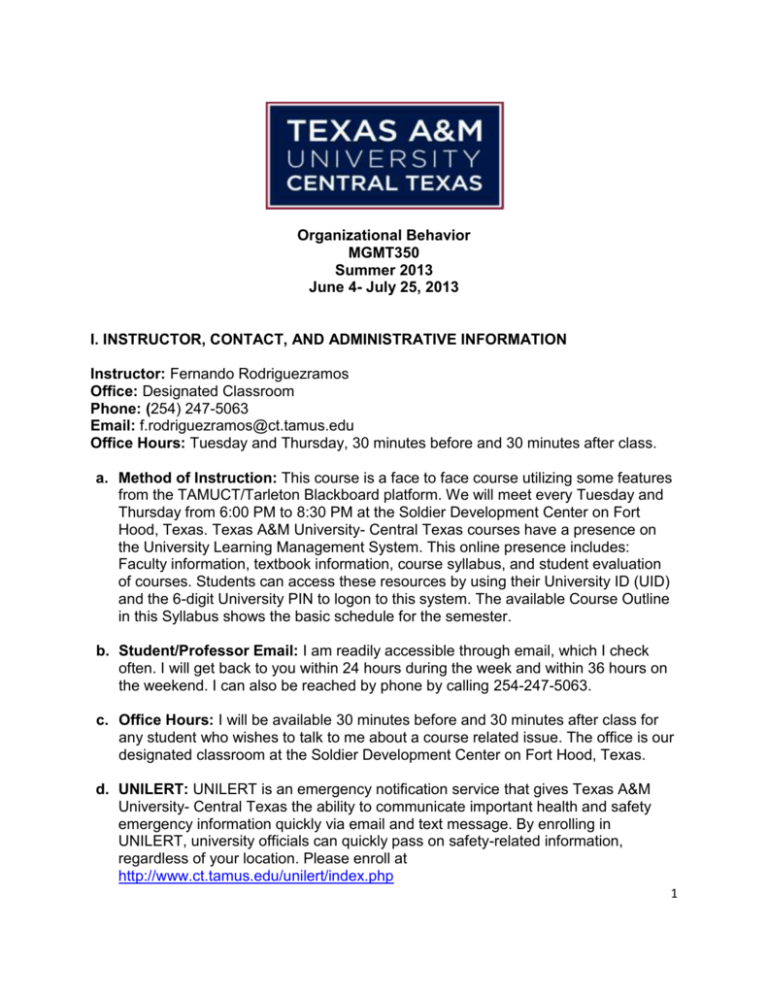
Organizational Behavior MGMT350 Summer 2013 June 4- July 25, 2013 I. INSTRUCTOR, CONTACT, AND ADMINISTRATIVE INFORMATION Instructor: Fernando Rodriguezramos Office: Designated Classroom Phone: (254) 247-5063 Email: f.rodriguezramos@ct.tamus.edu Office Hours: Tuesday and Thursday, 30 minutes before and 30 minutes after class. a. Method of Instruction: This course is a face to face course utilizing some features from the TAMUCT/Tarleton Blackboard platform. We will meet every Tuesday and Thursday from 6:00 PM to 8:30 PM at the Soldier Development Center on Fort Hood, Texas. Texas A&M University- Central Texas courses have a presence on the University Learning Management System. This online presence includes: Faculty information, textbook information, course syllabus, and student evaluation of courses. Students can access these resources by using their University ID (UID) and the 6-digit University PIN to logon to this system. The available Course Outline in this Syllabus shows the basic schedule for the semester. b. Student/Professor Email: I am readily accessible through email, which I check often. I will get back to you within 24 hours during the week and within 36 hours on the weekend. I can also be reached by phone by calling 254-247-5063. c. Office Hours: I will be available 30 minutes before and 30 minutes after class for any student who wishes to talk to me about a course related issue. The office is our designated classroom at the Soldier Development Center on Fort Hood, Texas. d. UNILERT: UNILERT is an emergency notification service that gives Texas A&M University- Central Texas the ability to communicate important health and safety emergency information quickly via email and text message. By enrolling in UNILERT, university officials can quickly pass on safety-related information, regardless of your location. Please enroll at http://www.ct.tamus.edu/unilert/index.php 1 II. COURSE INFORMATION a. Course Overview and Description: Organizational Behavior is a field of study that investigates the impact that individuals, groups and structure have on behavior within organizations, for the purpose of applying such knowledge toward improving an organization’s effectiveness. b. Student Learning Outcomes: Students completing this course will be able to understand the importance of taking a systematic approach to the study of individual and group behavior in organizational settings. They shall analyze, synthesize, comprehend, and explain all components of the OB model and its relationship to the successful operation of modern organizations. An extensive study of the principles of psychology, sociology, and social psychology will allow students to be more effective members of organizations to which they might belong now or in the future. At the close of the semester, students will be able: 1) To identify the factors that impact individual and group behavior in organizations and how organizations manage their environments. 2) To analyze, describe, and manage attitudes and behavior in organizations. 3) To improve and change individual, group, and organizational behavior to attain individual, group, and organizational goals. 4) To analyze organizational behavior at three levels: the individual, the group, and the organization as a whole. 5) To use the tools of organizational behavior to increase individual, team, and organizational effectiveness. c. Specific Learning Objectives for each text chapter are included as Appendix A to this Syllabus. d. Required Reading and Textbook(s): TEXT: McShane, Steven L., Von Glinow, Mary Ann (2012). Organizational Behavior, (6th ed.). New York: McGraw-Hill Irwin 978-0-07-763152-9. A student of this institution is not under any obligation to purchase a textbook from a university-affiliated bookstore. The same textbook may also be available from an independent retailer, including an online retailer. REFERENCE: American Psychological Association. (2009). Publication Manual of American Psychological Association (6th ed.). Washington, D.C III. COURSE REQUIREMENTS a. Introductory Biography (3 percent): This Is a required Introductory Biography 2 Statement (2-3 paragraphs) that includes: your major, where you are in your studies, a summary of work experience, aspirations for future career and some personal tidbit like family or hobbies. Evaluation criteria for this forum will be clear writing, and inclusion of all required elements. This introductory paper will help orient everyone to the “community” of our class, and let you begin thinking about how management fits in to your career aspirations. b. Exams (52 percent): There will a series of exams testing students’ knowledge of the key frameworks, terms, and concepts included in the assigned text chapters. Exams will be grouped as follows, and are not cumulative: Exam 1 will cover chapters 1-4 Exam 2 will cover chapters 14,5,6,7 Exam 3 will cover chapters 8-11 Exam 4 will cover chapters 12,13,15 Exams will be timed and once started, must be completed at that time. There will be no make-ups for missed exams unless there is a documented medical emergency. All exams will be performed using the University’s Blackboard Learning Management System. c. MGMT350 Case Study: Organizational Culture (30 Points). After chapter 14, you will have learned about organizational culture. The purpose of the Organizational Culture Case Study Project is to explore the organizational culture of a “real life” company. Using the information you have gleaned from Chapter 14 and class materials, perform a cultural analysis of an organization of your choice. Select an organization and do secondary research, using TAMU-CT library data bases and other resources, to study the organization’s culture. The organization you select should be a Fortune 500 company that has enough written about it in the business press (e.g., Business Week, Fortune, Forbes, The Wall Street Journal) for you to do an adequate cultural analysis. You will produce a 5 to 10-page written report (excluding cover sheet, references and any figures, tables or appendices). Your case analysis should provide: 1. A description of the elements of the company’s culture in terms of artifacts, shared values, and shared assumptions (worth 45% of the grade). 2. Your assessment of the relationship between the organization’s culture and company performance, including the effects of cultural strength, fit or alignment with its environment, adaptive culture, and how it works to socialize its employees to fit the organization’s culture (worth 45% of your grade). 3. Be sure and include at least ten references, which must be cited in the body of your paper (worth 10% of the grade). Referencing multiple pages from the same organization’s web site only count as one citation (e.g., Apple Inc.). When using more than one page from the same company, provide a URL that 3 links to the home page or entry page for the document. Also, if there isn't a date available for the document use (n.d.) for no date. 4. The due date for the Organizational Culture Case Study is June 27, 2013. The entire Case Study will be submitted as an email attachment to me in one PDF file. A paper copy must also be turned in to me on or before the due date. 5. Late submission of the Case Study will result in a grade reduction of 10% for each day it is late (maximum of 30%) and will not be accepted beyond three (3) days from the due date. d. Management Competency Journal (15 Percent): Each chapter in the text has cases and self-assessment exercises. In this course you are required to prepare a journal in which you record what you have learned from completing each of the assigned cases and exercises. The Management Competency Journal is where you should demonstrate that you have mastered and can apply course concepts. It is not enough to just list your answers. For “Case Studies,” read the case and then answer the questions at the end of the case be sure and apply the relevant course concepts as appropriate. Be sure and also include the Case Questions in bold along with your answers. For “Exercises” be sure that you discuss what you have learned about you. You are not required to duplicate or copy each exercise, just read and comply with the instructions for that particular exercise. Be sure and give your score for each exercise as part of your discussion. A well thought out and complete response to each case/self-assessment applies concepts from the text to fully support your analysis. Expected length for responses is 1-2 complete paragraphs per question. Submit this assignment to me as an email attachment on July 25, 2013. The entire Management Competency Journal will be submitted in one PDF file. A paper copy must also be turned in to me on or before the due date. The cover sheet will contain the following information: 1) “My Journal,” 2) student’s name, 3) course title and designator (e.g., Organizational Behavior, MGMT350), 4) instructor’s title and name, university name, and due date. No Late submissions of the Management Competency Journal will be accepted! The assigned cases and self assessments that will comprise your Management Competency Journal are: Chapter 1Chapter 2- Case Study 1.1- Hospitals Are Driving Toward a Leaner Organization Self- Assessment 2.6 – Are You Introverted or Extraverted? 4 Chapter 3Chapter 4Chapter 14Chapter 5Chapter 6Chapter 7Chapter 8Chapter 9Chapter 10Chapter 11Chapter 12Chapter 13Chapter 15- Self- Assessment 3.6 – How Much Does Work Define Your SelfConcept? Case 4.2 – Riding the Emotional Roller Coaster Case 14.1 – Hilton’s Transformation Self- Assessment 5.6 – Need Strength Questionnaire Self- Assessment 6.3 – What is your Attitude Toward Money? Self- Assessment 7.6 – Measuring Your Creative Personality Case 8.1 – The Outstanding Faculty Award Self- Assessment 9.6 – Are You an Active Listener? Case 10.2 – Nab’s Rogue Trader Self- Assessment 11.5 – What is Your Preferred Conflict Handling Style? Case 12.1 – Profitel Inc. Case 13.1 – Nokia’s Evolving Organizational Structure Self- Assessment 15.3 – Are You Tolerant of Change? IV. PROFESSIONAL WRITING AND COMMUNICATION STANDARDS a. Course Standards: Professional level writing and communication are critical skills in the business world. This standard should be displayed in all assignments for this class. All communications, both to the Professor and student colleagues should be kept professional, including classroom discussion and email correspondence. For written assignments, all work should be proofread, free of grammatical errors, include proper citations and be in accordance with American Psychological Association (APA) standards. For information on APA standards and correct citation formats consult the APA Publication Manual, and/or link to the following sources: http://www.tarleton.edu/library/userhelp/APA_format_bib.pdf http://www.library.cornell.edu/newhelp/res_strategy/citing/apa.html For Internet citations - http://owl.english.purdue.edu/owl/resource/560/10/ References in the body of your paper are not cited correctly. A sample paper using APA style guidelines can be reviewed at: http://www.dianahacker.com/pdfs/HackerShaw-APA.pdf b. Tutoring: Tutoring is available to all TAMUCT students, both on-campus and online. Subjects tutored include Accounting, Finance, Statistics, Mathematics, and Writing (APA). Tutors are available at the Tutoring Center in Founder's Hall, Room 204, and also in the Library in the North Building. Visit www.ct.tamus.edu/AcademicSupport and click "Tutoring Support" for tutor schedules and contact info. If you have questions or if you're interested in becoming a tutor, contact Academic Support Programs at 254-519-5830 or by emailing gnichols@ct.tamus.edu. Tutor.com is an online tutoring platform that enables TAMU-CT students to log-in and receive FREE online tutoring and writing support. This tool provides tutoring in Mathematics, Writing, Career Writing, Chemistry, Physics, Biology, Spanish, 5 Calculus, and Statistics. Chat live with a tutor 24/7 for any subject on your computer. To access Tutor.com, click on www.tutor.com/tamuct. c. Library Services: Information literacy focuses on research skills which prepare individuals to live and work in an information-centered society. Library research skills are another critical tool in the business world, and will be required for this class in conjunction with Management Portfolio Project. Librarians will work with students in the development of critical reasoning, ethical use of information, and the appropriate use of secondary research techniques. Help may include, yet is not limited to: exploration of information resources such as library collections and services, identification of subject databases and scholarly journals, and execution of effective search strategies. Library Resources are outlined and accessed at: http://www.tarleton.edu/centraltexas/departments/library/ d. The TAMUCT librarians are available to assist students doing research via email and chat sessions; consult the library link provided here or the library link on the course home page to access these services. V. GRADING POINTS AND POLICIES a. Percentage of each assignment as it contributes to your final grade: Activity Introductory Biography Exam # 1 Exam # 2 Exam # 3 Exam #4 Org Culture Project Management Competency Journal TOTAL Points & % of Final Grade 3% 13% 13% 13% 13% 30% 15% 100 % NOTE #1: There is NO EXTRA CREDIT in this course. NOTE #2: Requests for Incomplete Grades: Incompletes will only be given in emergency or other extreme circumstances. Any request for an incomplete grade in this course must be approved by the professor prior to the last week of classes. Where possible, requests should be submitted in written form and must include an address and/or telephone number where you may be contacted throughout the following semester. Tarleton State University uses the grade of ‘K’ on transcripts and grade reports to identify incomplete grades. NOTE #3: Questions concerning one’s grade on a particular task (e.g., test, case) 6 should be resolved within one week after receiving the graded material. There will be no reviewing of previously graded material at the end of the semester. b. Grading Policy: Minimum points required for a specific course grade are noted on the table below. Course Grades are assigned as follows: LETTERGRADE “A” “B” “C” “D” “F” EQUALS FROM TO == 90 % 100% == 80% 89% == 70% 79% == 60% 69% == Below 60% c. Posting of Grades: Student will be informed of their grades within one week of the assignment/test due date. V. TECHNOLOGY REQUIREMENTS AND SUPPORT Not Applicable VI. COURSE AND UNIVERSITY POLICIES/PROCEDURES a. Academic Integrity: Texas A&M University - Central Texas expects all students to maintain high standards of personal and scholarly conduct. Students guilty of academic dishonestly are subject to disciplinary action. Academic dishonesty includes, but is not limited to, cheating on an examination or other academic work, plagiarism, collusion, and the abuse of resource materials. The faculty member is responsible for initiating action for each case of academic dishonestly. More information can be found at www.ct.tamus.edu/StudentConduct. A found incidence of Academic Dishonesty for any assignment, project or exam in this class will result in 0 points. Multiple incidences will result in an F course grade. b. Disability Support and Access: If you have or believe you have a disability and wish to self-identify, you can do so by providing documentation to the Disability Support Coordinator. Students are encouraged to seek information about accommodations to help assure success in their courses. Please contact Gail Johnson at (254) 519-5831 or visit Founder's Hall 114. Additional information can be 7 found at www.ct.tamus.edu/AcademicSupport. c. Drop Policy: If you discover that you need to drop this class, you must go to the Records Office and ask for the necessary paperwork. Professors cannot drop students; this is always the responsibility of the student. Be sure to keep up with Registrar’s Office deadlines for withdrawing from this course, should your progress fall significantly behind. The record’s office will give a deadline for which the form must be returned, completed, and signed. Once you return the signed form to the records office and wait 24 hours, you must go into DuckTrax and confirm that you are no longer enrolled. If you are still enrolled, FOLLOW-UP with the records office immediately. Should you miss the deadline or fail to follow the procedure, you will receive an F in the course. “Incompletes” will be given in this class ONLY if a significant portion of the course has been completed and there is a documented medical or family emergency warranting the incomplete. VII. COURSE OUTLINE AND CALENDAR Unit Class/ Activities Subject Assignments Journal Assignment 1A Intro/Syllabus The Field of Chap 1 Organizational Behavior Read Syllabus Case 1.1 Hospitals Driving Toward a Leaner Organization 1B Chap 2 Individual Behavior, Values, & Personality Self- Assessment 2.6 Introductory Bio Statement Due 2A Chap 3 Perceptions & Learning in Organizations Self-Assessment 3.6 2B Chap 4 Workplace Emotions, Attitudes, and Stress Case 4.2 Riding the Emotional Roller Coaster Exam 1 Chap 1-4 3A Chap 14 Organization Culture CASE 14.1 Hilton’s Transformation. 3B Chap 5 Employee Motivation Self- Assessment 5.6 4A Chap 6 Applied Performance Practices Self- Assessment 6.3 Organizational Culture Project Due 4B Chap 7 Decision Making & Creativity Self- Assessment 7.6 Exam 2 Chap 14, 5, 6,7 5A Chap 8 Team Dynamics Case 8.1 – The Outstanding Faculty Award 8 5B Chap 9 Communication In Teams and Organizations Self- Assessment 9.6 6A Chap 10 Power & Influence Case 10.2 NAB’s Rogue Trader 6B Chap 11 Conflict and Negotiation Assessment 11.5 Exam 3 Chap 8-11 7A Chap 12 Leadership in Organizations Case 12.1 Profitel Inc. 7B Chap 13 Organizational Structure Case 13.1 Nokia’s Evolving Organizational Structure 8A Chap 15 Organizational Change Self- Assessment 15.3 8B Submit Management Competency Journal Exam 4 Chap. 12,13,15 This Syllabus is subject to change by the Professor. Should changes be made, students will be notified as soon as possible. 9 Appendix A MGMT 350 Student Learning Outcomes by Text Chapter On completing the learning activities for each chapter students will be able to do the following: Chapter 1: LO1 Define organizational behavior and organizations, and discuss the importance of this field of inquiry. LO2 Compare and contrast the four current perspectives of organizational effectiveness, as well as the early goal attainment perspective. LO3 Debate the organizational opportunities and challenges of globalization, workforce diversity, and virtual work. LO4 Discuss the anchors on which organizational behavior knowledge is based. Chapter 2: LO1 Describe the four factors that directly influence individual behavior and performance. LO2 Summarize the five types of individual behavior in organizations. LO3 Describe personality, the “Big Five” personality dimensions, and four MBTI types, and explain how personality relates to individual behavior in organizations. LO4 Summarize Schwartz's model of individual values and discuss the conditions under which values influence behavior. LO5 Describe three ethical principles and discuss four factors that influence ethical behavior. LO6 Review five values commonly studied across cultures and discuss cultural diversity within the United States. Chapter 3: LO1 Describe the elements of self-concept and explain how they affect an individual's behavior and well-being. LO2 Outline the perceptual process and discuss the effects of categorical thinking and mental models in that process. LO3 Discuss how stereotyping, attribution, self-fulfilling prophecy, halo, falseconsensus, primacy, and recency effects influence the perceptual process. LO4 Discuss three ways to improve perceptions, with specific applications to organizational situations. LO5 Outline the main features of a global mindset and justify its usefulness to employees and organizations. Chapter 4: LO1 Explain how emotions and cognition (logical thinking) influence attitudes and behavior. LO2 Discuss the dynamics of emotional labor and the role of emotional intelligence in 10 the workplace. LO3 Summarize the consequences of job dissatisfaction, as well as strategies to increase organizational (affective) commitment. LO4 Describe the stress experience and review three major stressors. LO5 Identify five ways to manage workplace stress. Chapter 5: LO1 Define employee engagement. LO2 Explain the role of human drives and emotions in employee motivation and behavior. LO3 Summarize Maslow's needs hierarchy, McClelland's learned needs theory, and four-drive theory, and discuss their implications for motivating employees. LO4 Discuss the expectancy theory model, including its practical implications. LO5 Outline organizational behavior modification (OB Mod) and social cognitive theory and explain their relevance to employee motivation. LO6 Describe the characteristics of effective goal setting and feedback. LO7 Summarize equity theory and describe ways to improve procedural justice. Chapter 6: LO1 Discuss the meaning of money and identify several individual, team, and organizational-level performance-based rewards. LO2 Describe five ways to improve reward effectiveness. LO3 List the advantages and disadvantages of job specialization. LO4 Diagram the job characteristics model and describe three ways to improve employee motivation through job design. LO5 Define empowerment and identify strategies that support empowerment. LO6 Describe the five elements of self-leadership and identify specific personal and work environment influences on self-leadership. Chapter 7: LO1 Describe the rational choice paradigm. LO2 Explain why people differ from the rational choice paradigm when identifying problems/opportunities, evaluating/choosing alternatives, and evaluating decision outcomes. LO3 Discuss the roles of emotions and intuition in decision making. LO4 Describe employee characteristics, workplace conditions, and specific activities that support creativity. LO5 Describe the benefits of employee involvement and identify four contingencies that affect the optimal level of employee involvement. Chapter 8: LO1 Discuss the benefits and limitations of teams, and explain why employees join informal groups. LO2 Outline the team effectiveness model and discuss how task characteristics, team size, and team composition influence team effectiveness. 11 LO3 Discuss how the four team processes—team development, norms, cohesion, and trust—influence team effectiveness. LO4 Discuss the characteristics and factors required for the success of self-directed teams and virtual teams. LO5 Identify four constraints on team decision making and discuss the advantages and disadvantages of four structures aimed at improving team decision making. Chapter 9: LO1 Explain why communication is important in organizations, and discuss four influences on effective communication encoding and decoding. LO2 Compare and contrast the advantages of and problems with electronic mail, other verbal communication media, and nonverbal communication. LO3 Explain how social acceptance and media richness influence the preferred communication channel. LO4 Discuss various barriers (noise) to effective communication, including crosscultural and gender-based differences in communication. LO5 Explain how to get messages across more effectively, and summarize the elements of active listening. LO6 Summarize effective communication strategies in organizational hierarchies, and review the role and relevance of the organizational grapevine. Chapter 10: LO1 Describe the dependence model of power as well as the five sources of power in organizations. LO2 Discuss the four contingencies of power. LO3 Explain how people and work units gain power through social networks. LO4 Describe eight types of influence tactics, three consequences of influencing others, and three contingencies to consider when choosing an influence tactic. LO5 Identify the organizational conditions and personal characteristics that support organizational politics, as well as ways to minimize organizational politics. Chapter 11: LO1 Define conflict and debate its positive and negative consequences in the workplace. LO2 Distinguish constructive from relationship conflict and describe three strategies to minimize relationship conflict during constructive conflict episodes. LO3 Diagram the conflict process model and describe six structural sources of conflict in organizations. LO4 Outline the five conflict handling styles and discuss the circumstances in which each would be most appropriate. LO5 Apply the six structural approaches to conflict management and describe the three types of third-party dispute resolution. LO6 Describe the bargaining zone model and outline strategies that skilled negotiators use to claim value and create value in negotiations. 12 Chapter 12: LO1 Define leadership and shared leadership. LO2 Identify eight competencies associated with effective leaders, and describe authentic leadership. LO3 Describe the key features of task-oriented, people-oriented, and servant leadership, and discuss their effects on followers. LO4 Discuss the key elements of path-goal theory, Fiedler's contingency model, and leadership substitutes. LO5 Describe the four elements of transformational leadership, and distinguish this theory from transactional and charismatic leadership. LO6 Describe the implicit leadership perspective. LO7 Discuss cultural and gender similarities and differences in leadership. Chapter 13: LO1 Describe three types of coordination in organizational structures. LO2 Discuss the role and effects of span of control, centralization, and formalization, and relate these elements to organic and mechanistic organizational structures. LO3 Identify and evaluate six types of departmentalization. LO4 Explain how the external environment, organizational size, technology, and strategy are relevant when designing an organizational structure. Chapter 14: LO1 Describe the elements of organizational culture and discuss the importance of organizational subcultures. LO2 List four categories of artifacts through which corporate culture is deciphered. LO3 Discuss the importance of organizational culture and the conditions in which organizational culture strength improves organizational performance. LO4 Compare and contrast four strategies for merging organizational cultures. LO5 Identify four strategies for changing or strengthening an organization's culture, including the application of attraction–selection–attrition theory. LO6 Describe the organizational socialization process and identify strategies to improve that process. Chapter 15: LO1 Describe the elements of Lewin's force field analysis model. LO2 Discuss the reasons people resist organizational change and how change agents should view this resistance. LO3 Outline six strategies for minimizing resistance to change, and debate ways to effectively create an urgency for change. LO4 Discuss how leadership, coalitions, social networks, and pilot projects influence organizational change. LO5 Describe and compare action research, appreciative inquiry, large group interventions, and parallel learning structures as formal approaches to organizational change. LO6 Discuss two cross-cultural and three ethical issues in organizational change. 13
